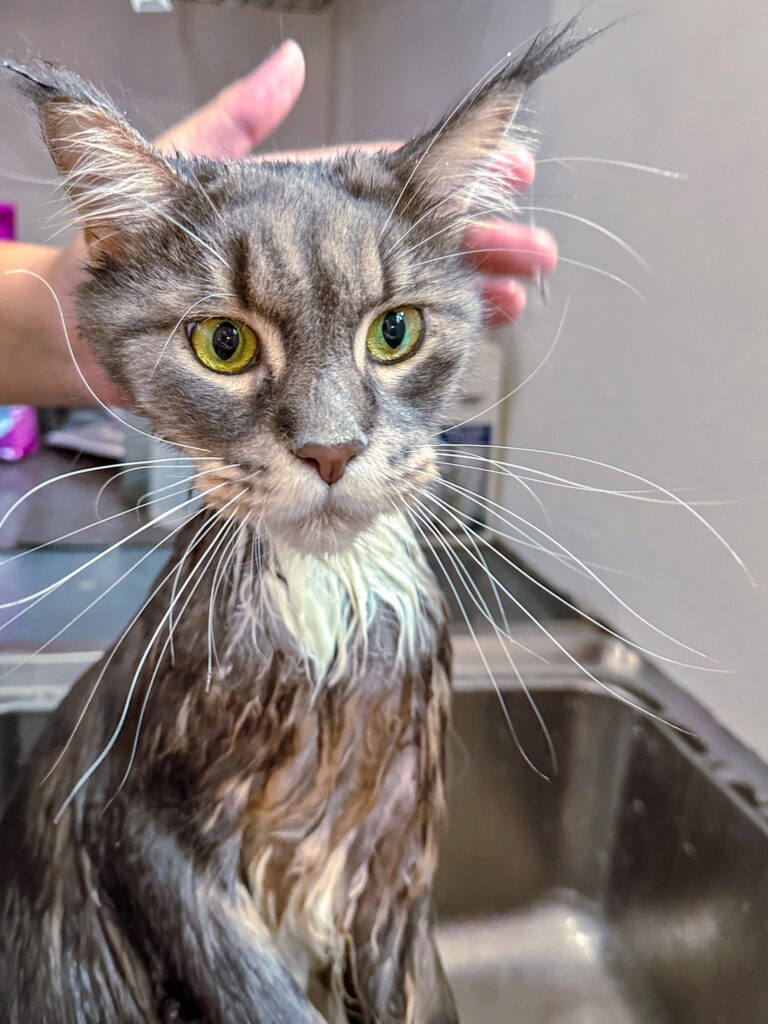Bathing your cat isn’t just about cleanliness, it’s about overall skin and coat health, comfort, and wellness. While cats are famously clean creatures, professional baths can offer benefits beyond what self-grooming provides, especially when done in the right way.
Do Cats Really Need Baths?
Cats do a good job grooming themselves, but there are many situations where a proper bath can make all the difference:
- Long-haired cats prone to tangles, matting, or greasy coats.
- Overweight or elderly cats who struggle to groom themselves properly.
- Allergies or dandruff causing flaky or irritated skin.
- Dirty or sticky fur after accidents or outdoor adventures.
- Shedding season, where bathing your cat helps remove dead fur and reduces hairballs.
At Lazy Cat Hotel, we believe cat grooming is not a “last resort.” When done gently and routinely, it supports your cat’s health and helps them feel fresh, light, and relaxed.
Signs Your Cat May Need a Bath
- Strong or musty odor despite self-grooming
- Greasy, sticky, or dusty fur
- Dandruff or visible flakes
- Tangled or matted coat
- Fleas or skin irritation
- Hasn’t been able to groom due to weight, age, or illness
How Often Should You Be Bathing Your Cat?
For most indoor cats, every 6–8 weeks is a healthy rhythm, especially if combined with brushing. For long-haired or senior cats, more frequent spa visits may be helpful.
Cats with oily skin, allergies, or dense undercoats often benefit from scheduled professional baths. If you’re not sure, a groomer can assess the coat and recommend the ideal frequency.
How to Bathe a Cat Without Stress
Bathing your cat can be a positive experience when done right:
- Use lukewarm water — never hot or cold.
- Start slowly if it’s your cat’s first bath.
- Place a non-slip mat under your cat’s feet.
- Speak gently and move calmly.
- Avoid pouring water over the face. Use a damp cloth to wipe it instead.
- Always use cat-specific products.
Afterward, wrap in a warm towel and blow dry with cold air only if your cat tolerates it. Otherwise, towel-dry thoroughly and let them rest in a warm, draft-free area.
What If My Cat Hates Water?
Many cats dislike the sensation of water, not bathing itself. A calm atmosphere, experienced handler, and gentle techniques make a huge difference. When introduced early, many cats enjoy spa time.
Cats that fear bathing may benefit from professional grooming, where the environment is designed for feline comfort.
Our Approach: The Lazy Cat Spa Experience
At Lazy Cat Hotel, we specialize in cat-only grooming with a spa atmosphere.
Every cat spa treatment begins with a degreasing product to soften the coat, followed by a gentle grooming shampoo for deep cleansing. This process:
- Loosens dead hair
- Reduces oil buildup
- Improves coat texture
- Prevents matting
- Supports healthy skin
Our treatments are safe, non-toxic, and tailored to your cat’s coat and temperament.
How to Choose the Right Grooming Salon for Your Cat
Not all pet salons are created equal, and cats have unique needs. When choosing a grooming service, look for:
- Cat-only or cat-specialized grooming (not just dog groomers)
- No physical restraints or muzzles — look for salons that groom calmly, with minimal stress
- Clean, quiet environment with separate spaces from dogs
- Trained groomers who handle cats gently and patiently
- Transparent process and willingness to answer questions
You should feel comfortable asking to see the grooming area or watching a session. Trust, communication, and environment matter.
FAQs for bathing your cat
Is it cruel to bathe cats?
No, when done properly and gently, bathing your cat is safe and can even be calming for many cats.
How can I bathe my cat without getting scratched?
Use a towel wrap or a cat grooming bag, stay calm, and never rush. If unsure, seek a professional.
Should I bathe my cat at home or go to a groomer?
Home baths can work for calm cats. But if your cat is anxious, has mats, or needs a deep cleanse, go to a professional.
How do I know if my cat needs a bath?
Oily fur, dandruff, odor, or visible dirt are common signs. Long-haired, senior, or indoor cats may also benefit from regular bathing.
Final Thoughts
Bathing your cat isn’t just about appearance, it’s about comfort, health, and bonding. With the right tools, products, and professional support, it can be a positive, even enjoyable routine.
Whether your cat is fluffy, short-haired, playful, or shy, our feline-first grooming philosophy makes every spa day a stress-free experience. Book a visit and see the difference it makes for your cat.







